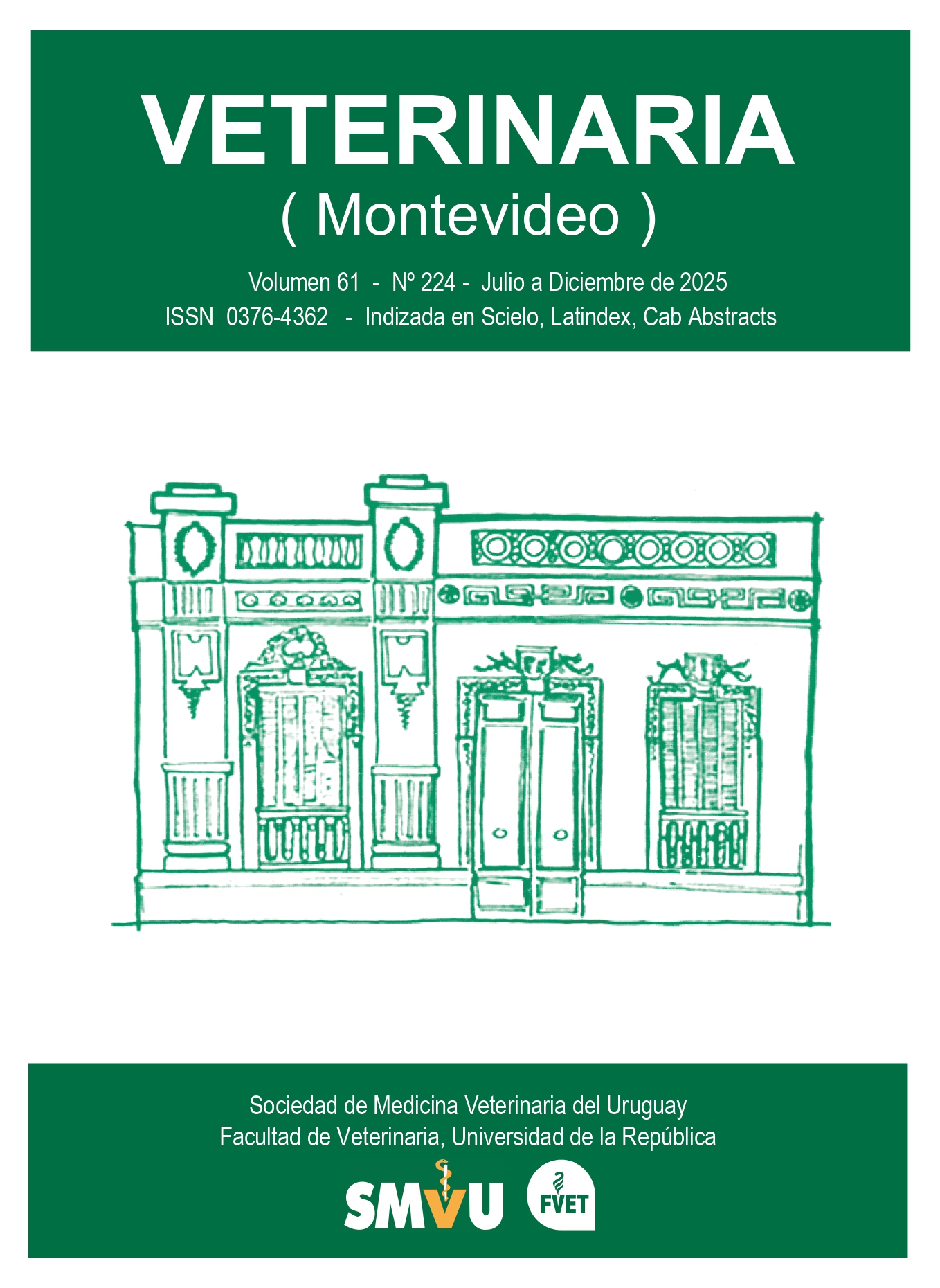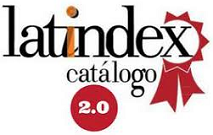Disfunción de la pars intermedia de la pituitaria
Estudio de caso
DOI:
https://doi.org/10.29155/VET.61.224.1Palabras clave:
Equino, Cushing, Hipertricosis, PituitariaResumen
La disfunción de la pars intermedia de la pituitaria (PPID; pituitary pars intermedia dysfunction) es un desorden endócrino que se presenta sobre todo en equinos gerontes, sin otra predisposición clara. Los principales signos clínicos son la hipertricosis, la letargia, la laminitis, la pérdida progresiva de peso y la atrofia de masa muscular. En los casos subclínicos se puede observar solamente disminución del rendimiento deportivo e infertilidad, lo que impacta económicamente en la industria. Dado que es una patología subdiagnosticada en Uruguay no existe tratamiento disponible. El objetivo de este trabajo fue reportar el primer caso con diagnóstico definitivo de PPID en un equino en el país.
Descargas
Métricas
Citas
Aleman, M., Watson, J. L., Williams, D. C., LeCouteur, R. A., Nieto, J. E., & Shelton, G. D. (2006). Myopathy in horses with pituitary pars intermedia dysfunction (Cushing’s disease). Neuromuscular Disorders, 16, 737-744. https://doi.org/10.1016/j.nmd.2006.07.019
Barrell, E. A. (2022). Polyuria and Polydipsia in Horses. Veterinary Clinics of North America: Equine Practice, 38, 95-108. https://doi.org/10.1016/j.cveq.2021.11.007
Beech, J., Boston, R., & Lindborg, S. (2011). Comparison of cortisol and ACTH responses after administration of thyrotropin releasing hormone in normal horses and those with pituitary pars intermedia dysfunction. Journal of Veterinary Internal Medicine, 25, 1431-1438. https://doi.org/10.1111/j.1939-1676.2011.00810.x
Bennaim, M., Shiel, R. E., & Mooney, C. T. (2019). Diagnosis of spontaneous hyperadrenocorticism in dogs. Part 1: Pathophysiology, aetiology, clinical and clinicopathological features. The Veterinary Journal, 252, 105342. https://doi.org/10.1016/j.tvjl.2019.105342
Bertin, F., & Fraser, N. (2020). Equine Endocrinology. Severn.
Cabrera Blatter, M. F., del Prado, A., Gallelli, M. F., D’Anna, E., Ivanic, J., Esarte, M., Miceli, D. D., Gómez, N. V., & Castillo, V. A. (2012). Blindness in dogs with pituitary dependent hyperadrenocorticism: Relationship with glucose, cortisol and triglyceride concentration and with ophthalmic blood flow. Research in Veterinary Science, 92(3), 387-392. https://doi.org/10.1016/j.rvsc.2011.04.017
Hart, K., Durham, A., Frank, N., McGowan, C., Schott, H., & Stewart, A.J. (2021). Recommendations on diagnosis and management of pituitary pars intermedia dysfunction (PPID). Equine Endocrinology Group. https://idppid.com/sites/default/files/2021%20EEG%20PPID%20Recommendations%20%281%29.pdf
Heinrichs, M., Baumgärtner, W., & Capen, C. C. (1990). Immunocytochemical demonstration of proopiomelanocortin-derived peptides in pituitary adenomas of the pars intermedia in horses. Veterinary Pathology, 27(6), 419-425. https://doi.org/10.1177/030098589902700606
Henneke, D. R., Potter, G. D., Kreider, J. L., & Yeates, B.F. (1983). Relationship between condition score, physical measurements and body fat percentage in mares. Equine Veterinary Journal, 15, 371-372. https://doi.org/10.1111/j.2042-3306.1983.tb01826.x
Horn, R., Bamford, N. J., Afonso, T., Sutherland, M., Buckerfield, J., Tan, R. H. H., Secombe, C. J., Stewart, A. J., & Bertin, F. R. (2019). Factors associated with survival, laminitis and insulin dysregulation in horses diagnosed with equine pituitary pars intermedia dysfunction. Equine Veterinary Journal, 51(4), 440-445. https://doi.org/10.1111/evj.13041
Horn, R., Stewart, A., Jackson, K., Dryburgh, E., Medina-Torres, C., & Bertin, F. (2021). Clinical implications of using adrenocorticotropic hormone diagnostic cutoffs or reference intervals to diagnose pituitary pars intermedia dysfunction in mature horses. Journal of Veterinary Internal Medicine, 35(1), 560-570. https://doi.org/10.1111/jvim.16017
Huang, L., Palmieri, C., & Bertin, F. R. (2022). Correlation of pituitary histomorphometry with dopamine and dopamine D2 receptor expression in horses with pituitary pars intermedia dysfunction. Research in Veterinary Science, 152, 427-433. https://doi.org/10.1016/j.rvsc.2022.08.018
Innerå, M., Petersen, A. D., Desjardins, D. R., Steficek, B. A., Rosser, E. J., Jr., & Schott, H. C., II. (2013). Comparison of hair follicle histology between horses with pituitary pars intermedia dysfunction and excessive hair growth and normal aged horses. Veterinary Dermatology, 24(1), 212–e47. https://doi.org/10.1111/j.1365-3164.2012.01080.x
Ireland, J., & McGowan, C. (2018). Epidemiology of pituitary pars intermedia dysfunction: A systematic literature review of clinical presentation, disease prevalence and risk factors. The Veterinary Journal, 235, 22-33. https://doi.org/10.1016/j.tvjl.2018.03.002
Kam, Y. N., McKenzie, K., Coyle, M., & Bertin, F. R. (2021). Repeatability of a thyrotropin-releasing hormone stimulation test for diagnosis of pituitary pars intermedia dysfunction in mature horses. Journal of Veterinary Internal Medicine, 35(6), 2885-2890. https://doi.org/10.1111/jvim.16281
Keen, J. A., McLaren, M., Chandler, K. J., & McGorum, B. C. (2004). Biochemical indices of vascular function, glucose metabolism and oxidative stress in horses with equine Cushing’s disease. Equine Veterinary Journal, 36(3), 226-229. https://doi.org/10.2746/0425164044877215
Kirkwood, N., Hughes, K., & Stewart, A. (2022). Pituitary pars intermedia dysfunction (PPID) in horses. Veterinary Sciences, 9(10), 556. https://doi.org/10.3390/vetsci9100556
Li, F. I., Spence, R. J., de Laat, M. A., Harris, P. A., Sonntag, J., Menzies-Gow, N. J., Durham, A. E., Bailey, S. R., & Sillence, M. N. (2023). Association between insulin dysregulation and adrenocorticotropic hormone in aged horses and ponies with no clinical signs of pituitary pars intermedia dysfunction. Equine Veterinary Journal, 55(6), 1003-1011. https://doi.org/10.1111/evj.13925
McFarlane, D. (2011). Equine pituitary pars intermedia dysfunction. Veterinary Clinics of North America: Equine Practice, 27, 93-113. https://doi.org/10.1016/j.cveq.2010.12.007
McFarlane, D. (2014). Pathophysiology and clinical features of pituitary pars intermedia dysfunction. Equine Veterinary Education, 26(11), 592-598. https://doi.org/10.1111/eve.12237
McFarlane, D., Dybdal, N., Donaldson, M. T., Miller, L., & Cribb, A. E. (2005). Nitration and increased alpha-synuclein expression associated with dopaminergic neurodegeneration in equine pituitary pars intermedia dysfunction. Journal of Neuroendocrinology, 17(2), 73-80. https://doi.org/10.1111/j.1365-2826.2005.01277.x
McFarlane, D., Hale, G. M., Johnson, E. M., & Maxwell, L. K. (2010). Fecal egg counts after anthelmintic administration to aged horses and horses with pituitary pars intermedia dysfunction. Journal of the American Veterinary Medical Association, 236(3), 330-334. https://doi.org/10.2460/javma.236.3.330
McGowan, T. W., Pinchbeck, G. P., & McGowan, C. M. (2013). Prevalence, risk factors and clinical signs predictive for equine pituitary pars intermedia dysfunction in aged horses. Equine Veterinary Journal, 45(1), 74-79. https://doi.org/10.1111/j.2042-3306.2012.00578.x
Meyer, J. C., Hunyadi, L. M., & Ordóñez-Mena, J. M. (2022). The accuracy of ACTH as a biomarker for pituitary pars intermedia dysfunction in horses: A systematic review and meta-analysis. Equine Veterinary Journal, 54(3), 457-466. https://doi.org/10.1111/evj.13500
Miller, A. B., Loynachan, A. T., Bush, H. M., Hart, K. A., Barker, V. D., Campana-Emard, A. G., Grubbs, S. T., & Adams, A. A. (2021). Effects of pituitary pars intermedia dysfunction and Prascend (pergolide tablets) treatment on endocrine and immune function in horses. Domestic Animal Endocrinology, 74, 106531 https://doi.org/10.1016/j.domaniend.2020.106531
Millington, W. R., Dybdal, N. O., Dawson, R., Jr, Manzini, C., & Mueller, G. P. (1988). Equine Cushing’s disease: differential regulation of beta-endorphin processing in tumors of the intermediate pituitary. Endocrinology, 123(3), 1598-1604. https://doi.org/10.1210/endo-123-3-1598
Morgan, R. A., Keen, J. A., Homer, N., Nixon, M., McKinnon-Garvin, A. M., Moses-Williams, J. A., Davis, S. R., Hadoke, P. W. F., & Walker, B. R. (2018). Dysregulation of cortisol metabolism in equine pituitary pars intermedia dysfunction. Endocrinology, 159(11), 3791-3800. https://doi.org/10.1210/en.2018-00726
Orth, D. N., Holscher, M. A., Wilson, M. G., Nicholson, W. E., Plue, R. E., & Mount, C. D. (1982). Equine Cushing’s disease: plasma immunoreactive proopiolipomelanocortin peptide and cortisol levels basally and in response to diagnostic tests. Endocrinology, 110(4), 1430-1441. https://doi.org/10.1210/endo-110-4-1430
Pease, A. P., Schott, H. C., II, Howey, E. B., & Patterson, J. S. (2011). Computed tomographic findings in the pituitary gland and brain of horses with pituitary pars intermedia dysfunction. Journal of Veterinary Internal Medicine, 25(5), 1144-1151. https://doi.org/10.1111/j.1939-1676.2011.00784.x
Rohrbach, B. W., Stafford, J. R., Clermont, R. S., Reed, S. M., Schott, H. C., II, & Andrews, F. M. (2012). Diagnostic frequency, response to therapy, and long-term prognosis among horses and ponies with pituitary par intermedia dysfunction, 1993-2004. Journal of Veterinary Internal Medicine, 26(4), 1027-1034. https://doi.org/10.1111/j.1939-1676.2012.00932.x
Schott, H. C. (2002). Pituitary pars intermedia dysfunction: equine Cushing’s disease. The Veterinary Clinics of North America: Equine Practice, 18(2), 237-270 https://doi.org/10.1016/s0749-0739(02)00018-4
Spelta, C. W. (2015). Equine pituitary pars intermedia dysfunction: current perspectives on diagnosis and management. Veterinary Medicine, 6, 293-300. https://doi.org/10.2147/VMRR.S74191
Spelta, C.W., & Axon, J.E. (2012) Case series of equine pituitary pars intermedia dysfunction in a tropical climate. Australian Veterinary Journal, 90(11), 451-456 https://doi.org/10.1111/j.1751-0813.2012.00997.x
Tatum, R. C., McGowan, C. M., & Ireland, J. L. (2020). Efficacy of pergolide for the management of equine pituitary pars intermedia dysfunction: A systematic review. Veterinary Journal, 266, 105562. https://doi.org/10.1016/j.tvjl.2020.105562
Publicado
Cómo citar
Número
Sección
Licencia
Derechos de autor 2025 Sociedad de Medicina Veterinaria del Uruguay-Facultad de Veterinaria, Universidad de la República

Esta obra está bajo una licencia internacional Creative Commons Atribución 4.0.











